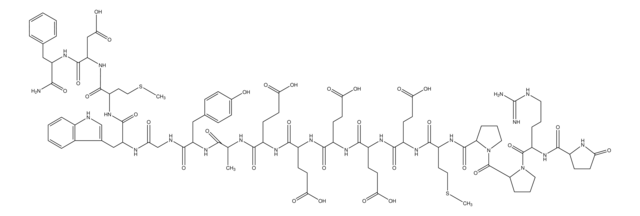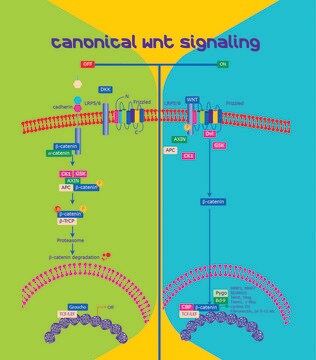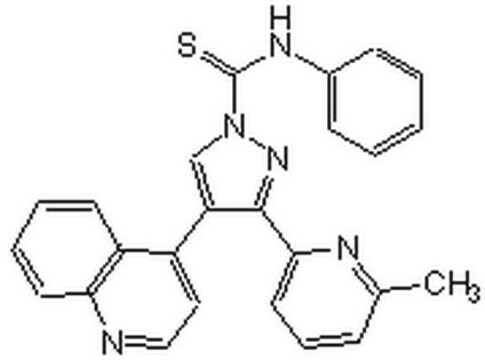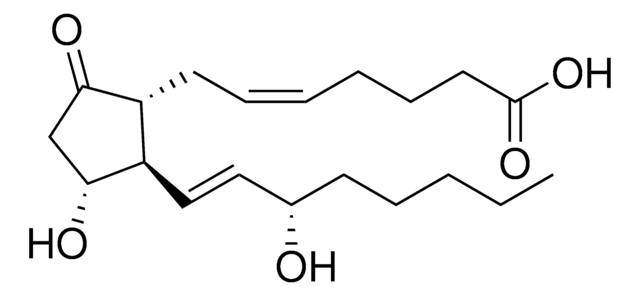About This Item
Wzór empiryczny (zapis Hilla):
C79H100N16O27
Masa cząsteczkowa:
1705.73
Kod UNSPSC:
51111800
NACRES:
NA.32
Polecane produkty
Próba
≥92% (HPLC)
Formularz
lyophilized
skład
Peptide Content, ≥75%
warunki przechowywania
protect from light
temp. przechowywania
−20°C
Amino Acid Sequence
Glp-Gly-Pro-Trp-Leu-Glu-Glu-Glu-Glu-Glu-Ala-Tyr-Gly-Trp
Opis ogólny
Gastrin, a classic digestive hormone, is found in three major forms: gastrin-34 (big gastrin), gastrin-17 (little gastrin), and gastrin-13 (minigastrin). Mammalian gastrin consists of a C-terminal four amino-acid sequence and a sulfated tyrosine 7 residue from the C-terminus. Gastrin is mostly found in the G cells of the stomach mucosa. Nutrients and gastrin-releasing peptides stimulate the release of gastrin.
Zastosowanie
Gastrin I (1-14) has been used:
- as a component of gastric cancer stem/progenitor cell (GCSPC) medium for tumorsphere culture
- as a supplement in organoid growth medium (OGM) for patient-derived organoid (PDO)
- in viable lymphocytes culture for re-stimulation assay
Działania biochem./fizjol.
Gastrin is a linear polypeptide that induces the secretion of gastric acid (HCl) by parietal cells.
The peptide gastrin I (1-14), which lacks a basic site, forms positive ions. Gastrin promotes the production and liberation of histamine in enterochromaffin-like cells through cholecystokinin 2 receptor (CCK2R). It also stimulates the release of gastric acid in parietal cells via the CCK2R receptor. Gastrin plays a key role in Zollinger-Ellison syndrome. It may play a role in the development of colorectal carcinoma.
Ta strona może zawierać tekst przetłumaczony maszynowo.
Kod klasy składowania
11 - Combustible Solids
Klasa zagrożenia wodnego (WGK)
WGK 3
Temperatura zapłonu (°F)
Not applicable
Temperatura zapłonu (°C)
Not applicable
Wybierz jedną z najnowszych wersji:
Certyfikaty analizy (CoA)
Lot/Batch Number
Nie widzisz odpowiedniej wersji?
Jeśli potrzebujesz konkretnej wersji, możesz wyszukać konkretny certyfikat według numeru partii lub serii.
Masz już ten produkt?
Dokumenty związane z niedawno zakupionymi produktami zostały zamieszczone w Bibliotece dokumentów.
Klienci oglądali również te produkty
C M Thorburn et al.
Gastroenterology, 115(2), 275-280 (1998-07-25)
Gastrin is a putative promoter of colorectal carcinomas. The aim of this study was to evaluate the temporal relationship between gastrinemia and development of colorectal malignancy. We conducted a nested case-control study among 128,992 subscribers to a health maintenance program
Zhi-Feng Miao et al.
Stem cells (Dayton, Ohio), 32(12), 3062-3074 (2014-08-22)
Peritoneal dissemination is the most common cause of death in gastric cancer patients. The hypoxic microenvironment plays a major role in controlling the tumor stem cell phenotype and is associated with patients' prognosis through hypoxia-inducible factor-1α (HIF-1α), a key transcriptional
Nicholas Osborne et al.
Cancer immunology, immunotherapy : CII, 68(10), 1635-1648 (2019-09-25)
Pancreatic cancer has been termed a 'recalcitrant cancer' due to its relative resistance to chemotherapy and immunotherapy. This resistance is thought to be due in part to the dense fibrotic tumor microenvironment and lack of tumor infiltrating CD8 + T cells. The
Junjie Gao et al.
Rapid communications in mass spectrometry : RCM, 22(24), 4066-4072 (2008-11-21)
Negative ion production from peptides and proteins was investigated by matrix-assisted laser desorption/ionization time-of-flight (MALDI-TOF) mass spectrometry. Although most research on peptide and protein identification with ionization by MALDI has involved the detection of positive ions, for some acidic peptides
F L Lai Benjamin et al.
Advanced functional materials, 30(48) (2021-03-12)
Tumor progression relies heavily on the interaction between the neoplastic epithelial cells and their surrounding stromal partners. This cell cross-talk affects stromal development, and ultimately the heterogeneity impacts drug efflux and efficacy. To mimic this evolving paradigm, we have micro-engineered
Nasz zespół naukowców ma doświadczenie we wszystkich obszarach badań, w tym w naukach przyrodniczych, materiałoznawstwie, syntezie chemicznej, chromatografii, analityce i wielu innych dziedzinach.
Skontaktuj się z zespołem ds. pomocy technicznej
![[Leu15]-Gastrin I human ≥95% (HPLC)](/deepweb/assets/sigmaaldrich/product/structures/153/342/d4cb3dd7-13f1-46cf-8d1f-3907a5de7a83/640/d4cb3dd7-13f1-46cf-8d1f-3907a5de7a83.png)












